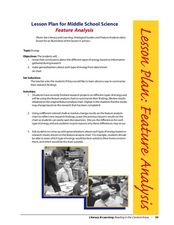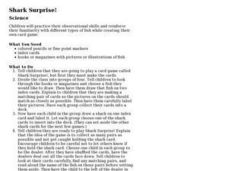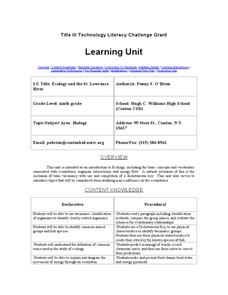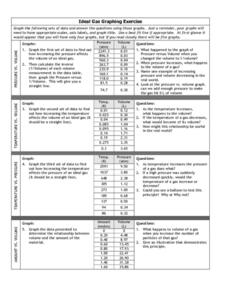Curated OER
Newton's Third Law of Motion
Students move through five stations demonstrating Newton's Third Law of Motion. In this Newtonian physics lesson, students watch as the instructor uses a firecracker to demonstrate action and reaction. The students travel to five...
Curated OER
Feature Analysis
Students research and analyze energy. In this energy lesson, students research types of energy and complete a feature analysis chart using chalk or markers. Students write generalizations about each type of energy based on their chart.
Curated OER
Canine Companions: Good or Bad? Proper Treatment of Dogs
Students explore the concept of proper canine treatment. In this social skills lesson, students decide if the teacher's statement about treatment of dogs is good or bad. Students then play games to show their new knowledge of the...
Curated OER
Sputnik
Students study Sputnik and what it looks like. In this Sputnik lesson students complete several activities while in groups.
Curated OER
Bringing Up Birdy
Students explore biology by creating diagrams of animal life cycles. In this baby bird lesson, students view video clips of birds being born from incubation to flying on their own. Students utilize the Internet to research birds and...
Curated OER
Shark Surprise
Students create a card game to review and reinforce their familiarity with different types of fish. They create and draw matching fish on index cards and label the pictures. They play the game to collect as many pairs as possible.
Curated OER
Insect or Spider?
Students compare and contrast the difference between insects and spiders. After a brief class discussion, students complete an activity matching the body parts of an insect and the body parts of a spider. Worksheet with answer key is...
Curated OER
Outbreak!
Students study and research drug-resistant bacteria and the use of antibiotics. Through the use of the internet, and other resources, students gather information and create a board game. They discuss bacteria, antibodies, antibiotics...
Curated OER
Wetland Welfare
Students research wetlands in the United States and create visual aids for use in oral presentations that make recommendations on preserving or restoring wetland welfare.
Curated OER
Properties of Waves
Third graders observe and investigate wave properties and compare the properties of particles and waves. They fill a pie pan half full with water, place a toothpick in the center of the pie pan, then drop a marble into the pan and...
Curated OER
Ecology and the St. Lawrence River
Ninth graders complete a unit of lessons on ecosystems, organism interactions, and energy flow. They create a key for known species of fish, diagram the movement of energy through an ecosystem, and create and present food chains and food...
Curated OER
Observation: It's A Natural!
Students play the role of naturalist in their own community just as Thoreau was in his. They observe their communities looking for positive and negative aspects on the environment. They work together in groups to complete a model for...
Curated OER
Some Fats Aren't Phat
Students examine nutritional information on various food labels and then consider the nutritional value of the foods in their own diets. They create posters illustrating their diets "before" and "after" they considered their fat intake.
Curated OER
Measuring Elapsed Time
Fifth graders convert units within the same measurement system and be able to determine elapsed time. They are given a start time and an end time of a game. Students determine the amount of elapsed time from the data that is given.
Curated OER
Understanding Digestion
Learners analyze data from their primary literature (textbook) and explore multiple
aspects of digestion by generating alternative or multiple explanations for questions posed during the instructional activity. This instructional...
Curated OER
Invertebrates and Vertebrate Evolution
Students explore the major characteristics of the major animal phyla. They describe adaptive features that have contributed to the success of animals on land. Students explain how primate evolution provides a context for understanding...
Curated OER
The Solar System
Students study the planets of the solar system. Students observe a model of the solar system, and name each planet, in order. In pairs, students write acronyms to assist in remembering the plants in order and share them with their...
Curated OER
How a Circuit Works
Learners explore the differences between parallel and series circuits by designing and constructing several different circuits. In small groups, they use miniature light bulbs, wires, and nine-volt batteries to build the circuits they...
Curated OER
Graphing Exercise of Ideal Gas Data
For this graphing of Ideal Gas Data worksheet, students use the given data to draw 4 graphs of the given data. They are given the pressure and volume to draw and interpret the graphs.
Curated OER
Regulating Gene Expression
In this genes worksheet, students review the system that controls gene expression and the enzymes required for regulating genetic expression. This worksheet has 6 fill in the blank and 7 short answer questions.
Curated OER
Sunlight and Warm Air
Students discuss radiant energy from the sun, performing a simple experiment with sun glasses and bright light to demonstrate the concept. Students further participate in simple in-class experiments to demonstrate: air density as it...
Curated OER
Hand Print Adjective Booklet
Students practice using adjectives by describing animals, pictures or insects. In this language arts lesson, students collaborate to brainstorm a list of adjectives which they turn into an adjective booklet. Students utilize their...
Curated OER
What In The World Are Swim Bladders and Why Are They Important
In this swim bladders worksheet, students use a bowl, water, and balloons to make swim bladders, and answer short answer questions about them. Students answer 7 questions and interview someone who has been scuba diving.
Curated OER
Environmentalists Internet Hunt
In this environmentalist worksheet, students click on the links in the questions about environmentalists to find the answers to the questions and then come back and answer the questions. Students answer 14 questions total.

























